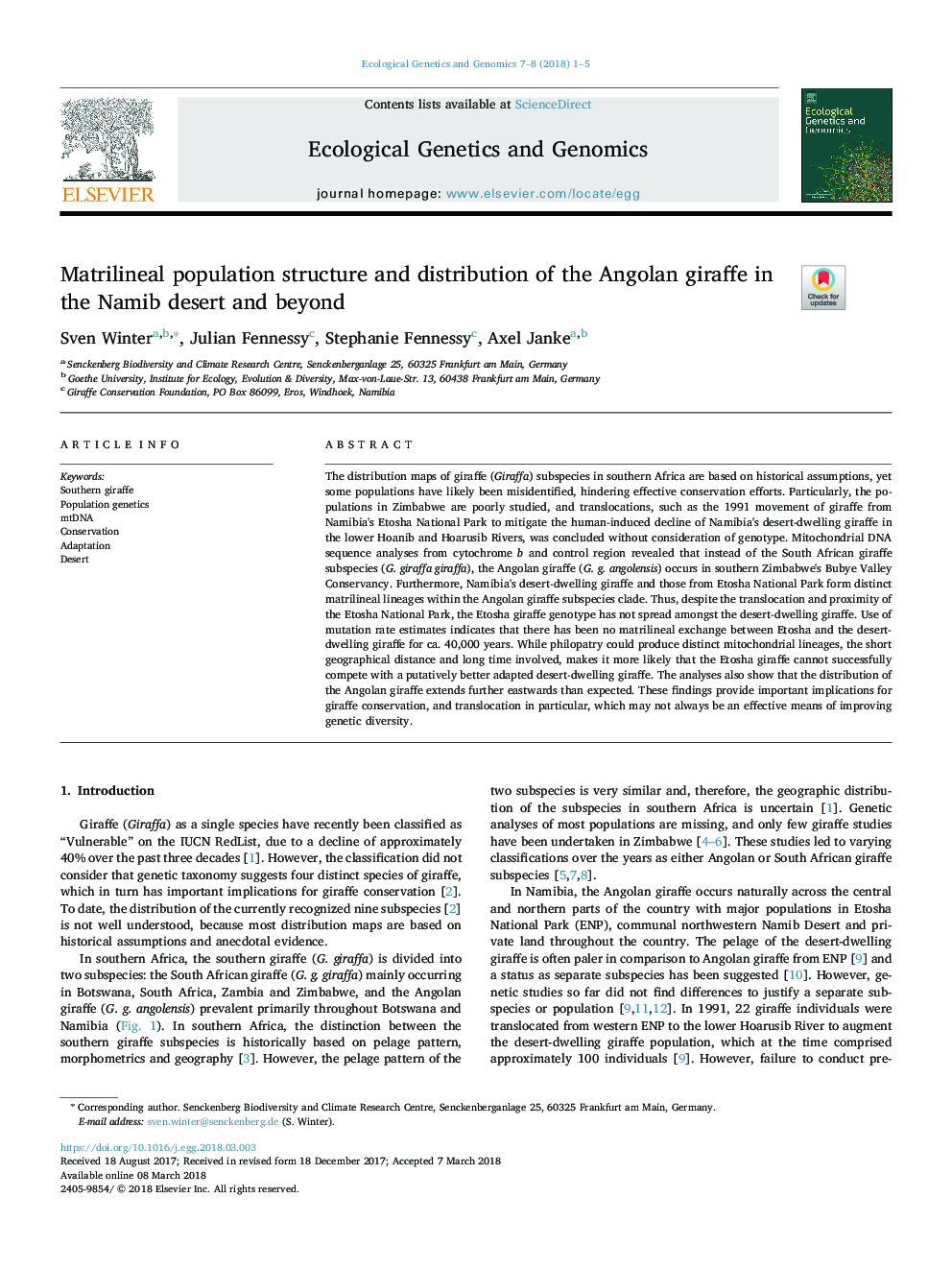| کد مقاله | کد نشریه | سال انتشار | مقاله انگلیسی | نسخه تمام متن |
|---|---|---|---|---|
| 8644121 | 1569419 | 2018 | 5 صفحه PDF | دانلود رایگان |
عنوان انگلیسی مقاله ISI
Matrilineal population structure and distribution of the Angolan giraffe in the Namib desert and beyond
ترجمه فارسی عنوان
ساختار جمعیت مادری و توزیع زرافه¬ی آنگولایی در بیابان نامیب و فراتر از آن
همین الان دانلود کنید
دانلود مقاله ISI انگلیسی
رایگان برای ایرانیان
کلمات کلیدی
زرافه¬ی جنوبی، ژنتیک جمعیت، mtDNA، حفاظت، سازگاری، بیابان
فهرست مطالب مقاله
چکیده
کلمات کلیدی
1.مقدمه
2.مواد وروشها
شکل 1. توزیع زیرگونه ی زرافه ی جنوبی
3.نتایج
شکل 2. فیلوژنسی و ساختار جمعیت در بین زرافه ی جنوبی
4.بحث
5.نتیجه گیری
کلمات کلیدی
1.مقدمه
2.مواد وروشها
شکل 1. توزیع زیرگونه ی زرافه ی جنوبی
3.نتایج
شکل 2. فیلوژنسی و ساختار جمعیت در بین زرافه ی جنوبی
4.بحث
5.نتیجه گیری
ترجمه چکیده
نقشه¬های توزیع زیرگونه¬های زرافه (Giraffa) در آفریقای جنوبی بر پایه¬ی فرضیات تاریخی است، هنوز بعضی از جمعیت¬ها احتمالا به درستی شناسایی نشده¬اند که مانع تلاش¬های حفاظتی موثر است. به ویژه جمعیت-ها و جابجایی¬های زیمباوه به طور ضعیفی مطالعه شده¬اند، مانند تغییر مکان سال 1991 زرافه¬های پارک ملی نامیبیا اتوشا برای کاهش انحطاط بشری زرافه¬های ساکن بیابان نامیبیا در رودخانه¬های پایین دست هوانیب و هواروسیب، که بدون در نظر گرفتن ژنوتیپ انجام شد. آنالیزهای توالی میتوکندری DNA از روی سیتوکروم b و ناحیه کنترل نشان داد که بجای زیرگونه¬های زرافه¬ی آفریقای جنوبی (G. giraffa giraffa)، زرافه¬ی آنگولایی (G. g. angolensis) در دره حفاظتی بابی زیمباوه¬ی جنوبی واقع شده است. بعلاوه، زرافه-ی ساکن بیابان نامیبیا و آنهایی که در پارک ملی اتوشا با اجداد مادری متمایز قراردارند نیز درون شاخه¬ی زیرگونه¬ی زرافه¬ی آنگولایی قرار می¬گیرند. بنابراین با وجود جابجایی و مجاورت پارک ملی اتوشا، ژنوتیپ زرافه¬ی اتوشا در بین زرافه¬ی ساکن بیابان پخش نشده است. استفاده از ارزیابی¬های نرخ جهش نشان داد که تبادل خطوط مادری بین زرافه¬ی اتوشا و ساکن بیابان برای 40000 سال وجود نداشته است. در حالی که فیلوپارتی می¬تواند اجداد مادری متمایز ایجاد کند، فواصل جغرافیایی کوتاه و زمان طولانی درگیر، این موضوع را محتمل¬تر می¬کند که زرافه¬ی اتوشا نمی تواند به طور موفقیت آمیزی با زرافه¬ی سازگارتر ساکن بیابان رقابت کند. همچنین آنالیزها نشان دادند که پراکندگی توسعه¬ی زرافه¬ی آنگولایی بیشتر از آنچه که انتظار می رفت به سمت شرق بود. این یافته¬ها مفاهیم مهمی را برای محافظت و به ویژه جابجایی زرافه ارائه می¬دهد، که ممکن است همیشه بهبود تنوع ژنتیکی یک ابزار موثر نباشد.
موضوعات مرتبط
علوم زیستی و بیوفناوری
بیوشیمی، ژنتیک و زیست شناسی مولکولی
ژنتیک
چکیده انگلیسی
The distribution maps of giraffe (Giraffa) subspecies in southern Africa are based on historical assumptions, yet some populations have likely been misidentified, hindering effective conservation efforts. Particularly, the populations in Zimbabwe are poorly studied, and translocations, such as the 1991 movement of giraffe from Namibia's Etosha National Park to mitigate the human-induced decline of Namibia's desert-dwelling giraffe in the lower Hoanib and Hoarusib Rivers, was concluded without consideration of genotype. Mitochondrial DNA sequence analyses from cytochrome b and control region revealed that instead of the South African giraffe subspecies (G. giraffa giraffa), the Angolan giraffe (G. g. angolensis) occurs in southern Zimbabwe's Bubye Valley Conservancy. Furthermore, Namibia's desert-dwelling giraffe and those from Etosha National Park form distinct matrilineal lineages within the Angolan giraffe subspecies clade. Thus, despite the translocation and proximity of the Etosha National Park, the Etosha giraffe genotype has not spread amongst the desert-dwelling giraffe. Use of mutation rate estimates indicates that there has been no matrilineal exchange between Etosha and the desert-dwelling giraffe for ca. 40,000 years. While philopatry could produce distinct mitochondrial lineages, the short geographical distance and long time involved, makes it more likely that the Etosha giraffe cannot successfully compete with a putatively better adapted desert-dwelling giraffe. The analyses also show that the distribution of the Angolan giraffe extends further eastwards than expected. These findings provide important implications for giraffe conservation, and translocation in particular, which may not always be an effective means of improving genetic diversity.
ناشر
Database: Elsevier - ScienceDirect (ساینس دایرکت)
Journal: Ecological Genetics and Genomics - Volumes 7â8, JulyâOctober 2018, Pages 1-5
Journal: Ecological Genetics and Genomics - Volumes 7â8, JulyâOctober 2018, Pages 1-5
نویسندگان
Sven Winter, Julian Fennessy, Stephanie Fennessy, Axel Janke,
